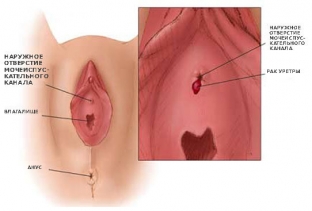Urethral cancer is a highly malignant urethral cancer that accounts for 2% of all urological neoplasms. Urethral cancer is more common in postmenopausal women. In most cases, cancer cells are located in the area of the external opening of the urethra. Since the main cause of the development of cancer of the urethra cannot be determined, it is believed that frequent urethritis is a predisposing factor in the development of the oncological process. Patients have a history of human papillomavirus infection, as well as gonorrhea, chlamydia, or mycoplasmosis.
Main clinical symptoms of urethral cancer
Permanent trauma to the urethra is considered a risk factor for the development of urethral cancer. Leukoplakia in this case can become an optional precancerous disease.
Clinical manifestations of urethral cancer are unspecific and quite variable. A tumor of the urethra in men is accompanied by difficulty urinating, up to its delay. In the area of the urethra, a seal is palpated, purulent discharge, urethrorhagia and microhematuria are characteristic. After some time, pain appears in the perineum and urethra, periurethral abscesses and fistulas form, inguinal lymph nodes increase, the penis and scrotum swell. In medicine, cases of prolonged painful erections on the background of urethral cancer are described. Symptoms of urethral cancer in women read more on estet-portal.com.
Clinical manifestations of urethral cancer in women:
- Pain and burning in the urethra.
- The process of urination is accompanied by pain, the occurrence of pain during intercourse is characteristic.
- Urinary incontinence, contact bleeding and urethrorhagia appear.
- When the tumor moves to the walls of the vagina, there is pain in the lower abdomen and bleeding from the vagina, the formation of urethro-vaginal fistulas is possible.
- The appearance of blood in the urine indicates the germination of urethral cancer in the wall of the bladder.
- If the tumor is localized in the region of the external opening of the urethra, the mass formation can be determined without problems by palpation and visually.
- The development of tumor thrombosis of the lymphatic ducts is accompanied by lymphostasis and edema of the lower half of the body.

Aspects of the diagnostic process for urethral cancer
Examination and questioning of the patient revealed frequent past urethritis, STDs, bladder cancer, benign neoplasms of the urethra and urethral diverticula.
Patients usually complain of blood in the urine, bloody discharge from the urethra, narrowing and spattering of the urine stream, difficulty urinating, men mention painful erections.
Examination of the urethra is performed using ureteroscopy, during which the urethra is examined. In the presence of urethral cancer, this method allows you to examine the mucous membrane of the urethra, to identify the location, depth and type of growth of the tumor.
Urethral cancer is characterized by tumor nodule density, underlying tissue infiltration, and easy bleeding on contact.
By biopsy, the histological structure of the tumor is revealed. A biopsy is performed using a ureteroscope using a puncture method or the method of transurethral resection of the neoplasm. In order to exclude the presence of metastases, excretory urography, chest x-ray, abdominal ultrasound and lymphadenography are performed.
Urethral cancer is differentiated from bladder strictures and urethral stones, in men - from chronic prostatitis, prostate cancer, in women - from paraurethral cysts and prolapse of the urethral mucosa. Urethral cancer is treated with surgery combined with radiotherapy.






Add a comment